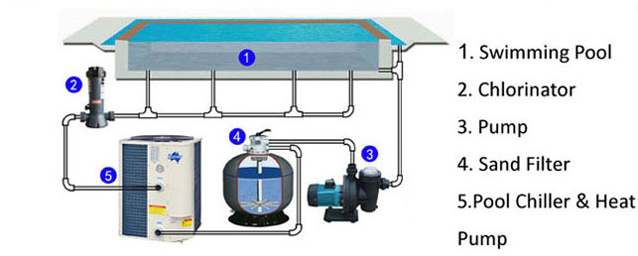Geothermal Source Heat Pump Principle
Work in the reverse way of air conditioner
Geothermal Source heat pump is also a kind of air conditioner, and it transfer heat from water to house. We know the air conditioner in our house it absorb the heat in our room and release it outside, and thus makes the room temperature decline. Comparing with our home air conditioner The Geothermal Source heat pump works in the reverse way. It absorb the heat in the ground water or other water and transfer it to house to heat water or air in the room.
What is a Geothermal Source heat pump consist of?
Before we talk about the principles of Geothermal Source heat pump we have learn the components of a Geothermal Source heat pump.Usually it consists of three components:
1. Heat source system
2. Heat pump
3. Heat distribution and storage system
Geothermal Source Heat pump cycle
Geothermal Source heat pump cycle is usually vapor-compression cycle
the same as most other heat pumps. Refrigeration flow in the closed heat pump circuit to transfer & transport the heat in four steps:
Step 1
a circulating refrigerant such as Freon enters the compressor as a vapor. The vapor is compressed at constant entropy and exits the compressor superheated.
Step 2
The superheated vapor travels through the condenser which first cools and removes the superheat and then condenses the vapor into a liquid by removing additional heat at constant pressure and temperature. For water heating the condenser is most coaxial tube heat exchanger.
pic-1 tube in tube heat exchanger
Step 3
The liquid refrigerant goes through the expansion valve (also called a throttle valve) where its pressure abruptly decreases, causing flash evaporation and auto-refrigeration of, typically, less than half of the liquid.
Step 4
That results in a mixture of liquid and vapor at a lower temperature and pressure. The cold liquid-vapor mixture then travels through the evaporator and is completely vaporized by the warm water from ground, river or other places. Usually the evaporator is tube-in-tube heat exchanger as Pic-1. The resulting refrigerant vapor returns to the compressor inlet to complete the thermodynamic cycle.
In this way it begins all over again.
Advantages of Geothermal Source Heat Pumps(GSHP)
➤Heat pumps save money.
Heat pumps are much cheaper to run than direct electric heating. They are cheaper to run than oil boilers and can be cheaper than running gas boilers. Because heat pumps can be fully automated they demand much less work than biomass boilers.
➤Heat pumps save carbon emissions.
Unlike burning oil, gas, LPG or biomass, a heat pump produces no carbon emissions on site (and no carbon emissions at all, if a renewable source of electricity is used to power them).
➤Heat pumps save space.
There are no fuel storage requirements.
➤Heat pumps are safe.
There is no combustion involved and no emission of potentially dangerous gases. No flues are required.
➤Other advantages
Heat pumps require less maintenance than combustion based heating systems.A well designed ground source heat pump system will increase the sale value of our property.
Heat pumps can provide cooling in summer, as well as heating in winter.
The planning authorities like ground source systems as they are safe, silent, invisible heating systems with low environmental impact.
The Government likes ground source systems and offers a much higher rate of Renewable Heat Incentive than for other renewable technologies.
Disadvantages of Geothermal Source Heat Pumps(GSHP)
➤GSHPs are more expensive to install than air source heat pumps because of the need to install a ground heat exchanger. However, this connection to the ground is what enables a GSHP to perform much more efficiently than an ASHP – particularly when the external air temperature is low in winter and we most need heating.
➤Problems arise with ground source heat pumps if the installation is poorly designed or not matched to the heating needs of the building. The design and installation of an effective ground source system depends on a thorough understanding of the movement of heat in







Comments
Post a Comment